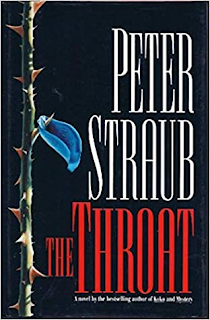The Throat by Peter Straub
Hello, Stranger.
Let's talk about Peter Straub's The Throat.
The Short of It
Plot: Tim Underwood and Tom Pasmore team up to investigate a death close to Underwood.
Page Count: 692
Award: None, final book in Blue Rose Trilogy
Worth a read: NoPrimary Driver: (Plot, World, or Character)
Bechdel Test: Fail
Technobabble: None.
Review: A decent horror thriller with interesting meta-fiction elements. However, it feels less like a culmination of a trilogy than a retread, and does not build appreciably upon Mystery. Main character work generally solid, but falls off for side characters. Writing is good, plot is messy. Pacing is alright for a 700 page tome, but the story does not justify its length.
The Medium of It
Spoiler Free!
Spoilers for Koko and Mystery.
A preface for everything that comes: there will not be much discussion of the story itself. This is a solid suspense/mystery novel, that is a bit too long. Straub is a better-than competent writer. As a suspense novel it is enjoyable enough, and better than many. The issues with it are more in how it is framed.
This book begins by fully embracing its meta-fiction identity. It's a bold way to kick things off, and an intriguing one. There are four words on the first two pages. Part One. Tim Underhill.
Tim Underhill, an author, and one of the major characters in Koko. Whose book is pretty important to Tom Pasmore and von Heilitz. The preface here makes it clear that both Koko and Mystery are based-upon-a-true-story books by Tim Underhill.
Perhaps it is excessive to keep on harping on this point, but the blurred lines between what is real and not in-universe are at the heart of the book. Which is to say, buckle up, we're gonna get into it. As noted in the review of Mystery, Straub describes Millhaven as a version of Milwaukee that allows for greater liberties to be taken. Mill Walk, then, is Timothy Underhill's depiction of Millhaven
From Mystery:
Tom had expected The Divided Man to be set on Mill Walk, but Underhill had located the murders in a gritty Midwestern industrial city of chain-link fences, inhuman winters, foundries, and a thousand bars. Its only real resemblance to Mill Walk was that the city’s wealthiest citizens lived on the far east side, in great houses built on a bluff above the shore of an enormous lake.
It seems unlikely that this trilogy was planned to go in the direction that it ultimately does. If so, some of the choices made in Mystery stop making sense. In this case: Why would Tom Pasmore, who is from Millhaven, note that a book was going on in the in-universe real town as opposed to his fictional version of it?
I enjoy some good meta-fiction. Pushing the boundaries of genre can create truly unique reading experiences, and House of Leaves is an excellent example of just that. Where The Throat and arguably the Blue Rose Trilogy as a whole stumbles is in lack of planning. A multi-tiered story in a story works well only when planned and plotted in a way that embraces the different levels of reality. And this just is not that. It feels like an interesting literary experiment that was chosen far too late.
Both Tim Underhill and Tom Pasmore are main characters, though the whole book is written in first person perspective from Underhill. Both are well written and sufficiently complex to be interesting. There are some meta-fiction complications here too: the Tom we got to know in Mystery is, after all, not a real person.
As for the story itself: not much to say. It's another Straub thriller. Sudden extreme gore is to be expected, most people are monsters, everything is connected, etc. etc. Not a bad book, but probably not worth the time.
If you're in the mood for this kind of thriller, however, don't let me stop you! Consider using the following link. I'll get a few cents at no cost to you!
The Long of It
Spoilers Ahead!
Did you think we were done with meta-fiction? Perish the thought! Because it's a fun convention, Bizarro Tom is the version from Mystery, while Tom is the "real" version from The Throat.
One of the big twists here is that some of the formative experiences that Bizarro Tom endures in Mystery were actually things that happened to Tim Underhill. At first glance this seems like a clever choice: it means that the events were real, just ascribed to a different person. The issue is that it has much greater ramifications. Mystery begins with Bizarro Tom surviving a near-fatal car accident, which ends up being the impetus for most of what happens in the book - it is how he ends up getting closer to von Heilitz, and thus becomes a bookworm and then detective. It is the reason that he ends up involved in hospital drama, which ends up offering some crucial threads later on.
But Tom was not the one who survived the car crash - it was Underhill (and, according to Wikipedia, Straub himself who was in an accident as a child). Mystery is still supposed to be mostly in-universe accurate. The threads just do not weave together quite right.
For a great example of meta-fiction, I highly recommend the 2006 movie The Fall.
Could you just be a stand-in for the author, Stranger?
And don't forget to read a book!


Comments
Post a Comment